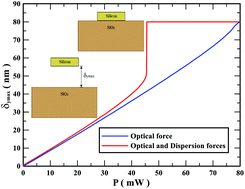Our official English website, www.x-mol.net, welcomes your
feedback! (Note: you will need to create a separate account there.)
Rigorous analysis of Casimir and van der Waals forces on a silicon nano-optomechanical device actuated by optical forces
Nanoscale ( IF 5.8 ) Pub Date : 2018-01-19 00:00:00 , DOI: 10.1039/c7nr09318g Janderson R. Rodrigues 1, 2, 2, 3, 4 , Andre Gusso 3, 5, 6, 7 , Felipe S. S. Rosa 3, 8, 9, 10 , Vilson R. Almeida 1, 2, 2, 3, 4
Nanoscale ( IF 5.8 ) Pub Date : 2018-01-19 00:00:00 , DOI: 10.1039/c7nr09318g Janderson R. Rodrigues 1, 2, 2, 3, 4 , Andre Gusso 3, 5, 6, 7 , Felipe S. S. Rosa 3, 8, 9, 10 , Vilson R. Almeida 1, 2, 2, 3, 4
Affiliation

|
Nano-optomechanical devices have enabled a lot of interesting scientific and technological applications. However, due to their nanoscale dimensions, they are vulnerable to the action of Casimir and van der Waals (dispersion) forces. This work presents a rigorous analysis of the dispersion forces on a nano-optomechanical device based on a silicon waveguide and a silicon dioxide substrate, surrounded by air and driven by optical forces. The dispersion forces are calculated using a modified Lifshitz theory with experimental optical data and validated by means of a rigorous 3D FDTD simulation. The mechanical nonlinearity of the nanowaveguide is taken into account and validated using a 3D FEM simulation. The results show that it is possible to attain a no pull-in critical point due to only the optical forces; however, the dispersion forces usually impose a pull-in critical point to the device and establish a minimal initial gap between the waveguide and the substrate. Furthermore, it is shown that the geometric nonlinearity effect may be exploited in order to avoid or minimize the pull-in and, therefore, the device collapse.
中文翻译:

对卡西米尔和范德华力的严格分析,该力是由光学力驱动的硅纳米光机械设备上的
纳米光机械设备已经实现了许多有趣的科学和技术应用。但是,由于它们的纳米级尺寸,它们容易受到卡西米尔(Casimir)和范德华(van der Waals)(分散)力的作用。这项工作对基于硅波导和二氧化硅衬底,被空气包围并受光力驱动的纳米光机械设备上的色散力进行了严格的分析。色散力是使用修正的Lifshitz理论和实验光学数据计算得出的,并通过严格的3D FDTD仿真进行了验证。考虑到纳米波导的机械非线性,并使用3D FEM仿真进行了验证。结果表明,仅由于光学力就有可能达到无拉入临界点。然而,色散力通常会向器件施加一个引入临界点,并在波导和基板之间建立最小的初始间隙。此外,示出了可以利用几何非线性效应来避免或最小化拉入,并且因此避免器件崩溃。
更新日期:2018-01-19
中文翻译:

对卡西米尔和范德华力的严格分析,该力是由光学力驱动的硅纳米光机械设备上的
纳米光机械设备已经实现了许多有趣的科学和技术应用。但是,由于它们的纳米级尺寸,它们容易受到卡西米尔(Casimir)和范德华(van der Waals)(分散)力的作用。这项工作对基于硅波导和二氧化硅衬底,被空气包围并受光力驱动的纳米光机械设备上的色散力进行了严格的分析。色散力是使用修正的Lifshitz理论和实验光学数据计算得出的,并通过严格的3D FDTD仿真进行了验证。考虑到纳米波导的机械非线性,并使用3D FEM仿真进行了验证。结果表明,仅由于光学力就有可能达到无拉入临界点。然而,色散力通常会向器件施加一个引入临界点,并在波导和基板之间建立最小的初始间隙。此外,示出了可以利用几何非线性效应来避免或最小化拉入,并且因此避免器件崩溃。










































 京公网安备 11010802027423号
京公网安备 11010802027423号